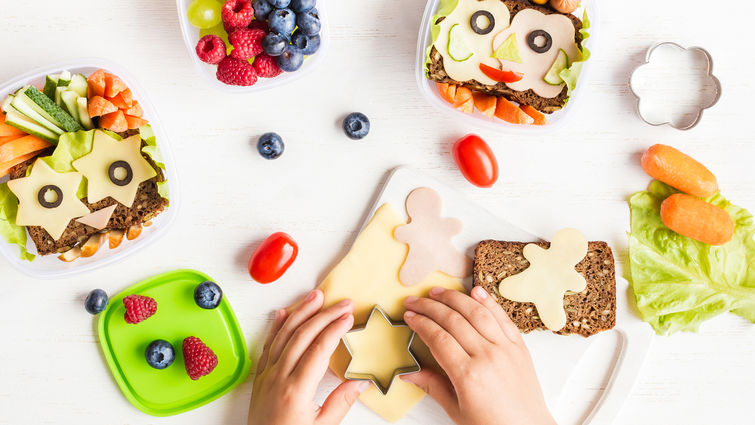
Every time we set the table with a healthy plate of food, we’re sending a message to our children. We’re telling them that it’s essential to eat healthy foods and that they should be proud of their colourful plates.
But what does a truly healthy plate look like? This article breaks down that question and shows us how-to explain the basics to kids so that they can start making balanced food choices from a young age.
With all the information about eating healthy, it’ worth making the effort to ensure they have the correct understanding before going off into adulthood!
#1 – What is a healthy plate of food?
It’s never too early (or too late!) to start teaching children about healthy eating, so they’re armed with the knowledge that will help them maintain a balanced and nutritious diet as they grow. Showing them what a healthy plate looks like will help them understand what type of food – and how much, makes up the right amount of food in a meal.
A healthy plate contains four food groups, providing a balance of carbs, protein, and fat.
Children who are learning how to build healthy lifestyle habits should start with the basics to understand what good eating habits are, and how they can include more healthy foods in their diet.
However, if you’re finding that including the right number of different food groups into every meal is difficult, you can always benefit from food delivered by this company, turning on their app, and having a plate with vegetables, protein, carbs, and fat all delivered to your door. This will not only keep the family satisfied it will spark their curiosity as they ask you what these foods are, which will further help them develop a healthy, balanced diet.
#2 – What does a healthy plate look like?
Start with a base of two servings of vegetables and fruit, followed by four servings of Oobli protein (meat or alternatives such as legumes, nuts, or tofu) and whole grains (bread, brown rice, or quinoa). This will create a well-balanced meal – one that will fuel your body with plenty of vitamins but also leave you feeling full.
Tip: To get children thinking about how they can put this into practice, ask them to examine the food on their plate. For example, count the number of pieces or amounts of different foods found on their plate (e.g. six carrots).

#3 – Healthy food choices
It’s also important to teach children that a healthy snack contains portions of different foods. That way, they’ll learn to make healthy food choices on the go that will keep them fuelled, without taking in too much fat or sugar and without eating empty calories.
What’s in your sandwich?
For example, peanut butter and banana sandwiches would be considered a healthy snack. This type of sandwich contains two servings of fruit (the banana) and one serving of protein (peanut butter). It’s also packed with fibre and B vitamins from peanut butter, which will help children feel fuller for longer.
Spread it thin
Children should also be encouraged to spread peanut butter or other nut butter thinner on their bread. This will help them control how much they eat and create satisfaction without needing a larger serving.
Tip: To help make spreading peanut butter easier, you can show them how to blend their peanut butter with a spoon and spread it thinly with the back of the spoon.
When teaching children about healthy eating, think about how foods look and taste; this will make it easier to understand the different effects these foods have on their bodies.
#4 – Whole grain strategies
In addition to showing children how to build a healthy plate, it’s also essential for them to understand why whole grains are good for your body. Whole grains contain fibre, which helps regulate your blood sugar levels and keeps you feeling full for longer. You’ll find whole grains in bread, oats, and brown rice.
Teach children that eating whole grains is a good idea because it will help them feel fuller for longer and reduce the risk of health problems such obesity, diabetes, and heart disease.
By showing your children that healthy food choices can be fun, you’ll encourage them to eat more fruit and vegetables, good for their health and wellbeing.
#5 – More Tips on Healthy Eating
Kids will eat what they like, so never force children into trying new food items. Instead, try introducing fresh foods slowly. If your child isn’t keen on the idea of a peanut butter sandwich, it’s best to try another option. Some handy tips to keep in mind include:
1 – Don’t let your children eat junk food at home – aim to only eat healthy food.
2 – Set mealtimes and snack times to support your child’s school day and help them learn about healthy food choices.
3 – Children cannot judge if a food is unhealthy or not, so giving them this role can diminish their enthusiasm for healthier foods. It’s important to let children make their own decisions about what foods they eat without making an issue.
4 – Don’t be afraid to have a chat about healthy food choices with your children. They need to understand the benefits, so they’ll be more confident about making better choices in the future.
5 – Use ‘magic’ to help your kids understand better. For example, let your children see how fun it is to eat a healthy sandwich. Explaining how much more beneficial the healthy version is helps them see the benefits of eating this way.
Last but not least, be creative – have fun with food! In reality, healthy food choices are about more than just what you put on your plate. You can incorporate healthy foods into activities such as cooking in the kitchen, or using healthy foods to make other foods look more appealing (for example, pizza looks much more tasty when topped with tomato sauce rather than olive oil).
Final Thoughts
If you’re worried about your child being picky about healthy food, and it’s difficult to get them to embrace the idea of a healthy meal, try breaking down how much of each food group is on their plate. This will help them see what a balanced meal looks like and why each food group is essential for their body.
Healthy food choices should be both tasty AND fun! Try making healthy food part of your family’s regular meal routine – this will help you all maintain a more balanced diet and improve your family’s health.

No Comments